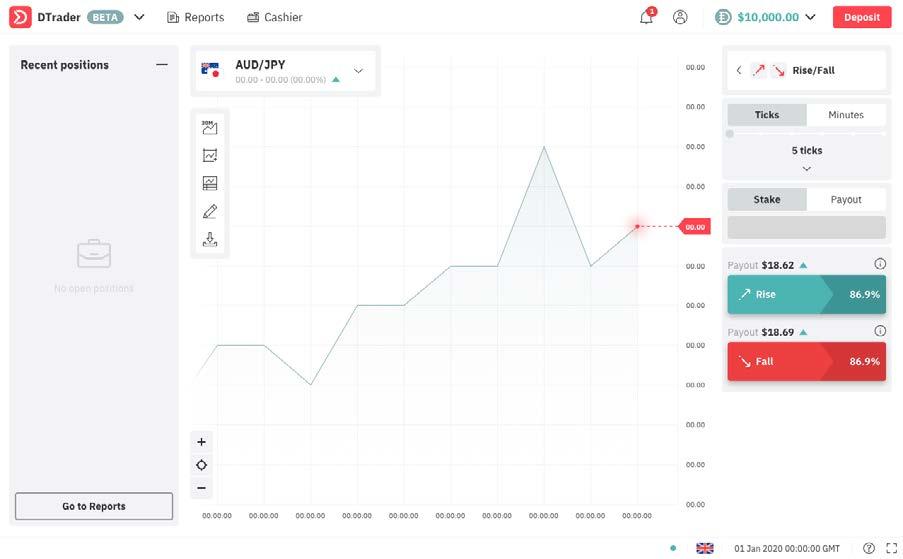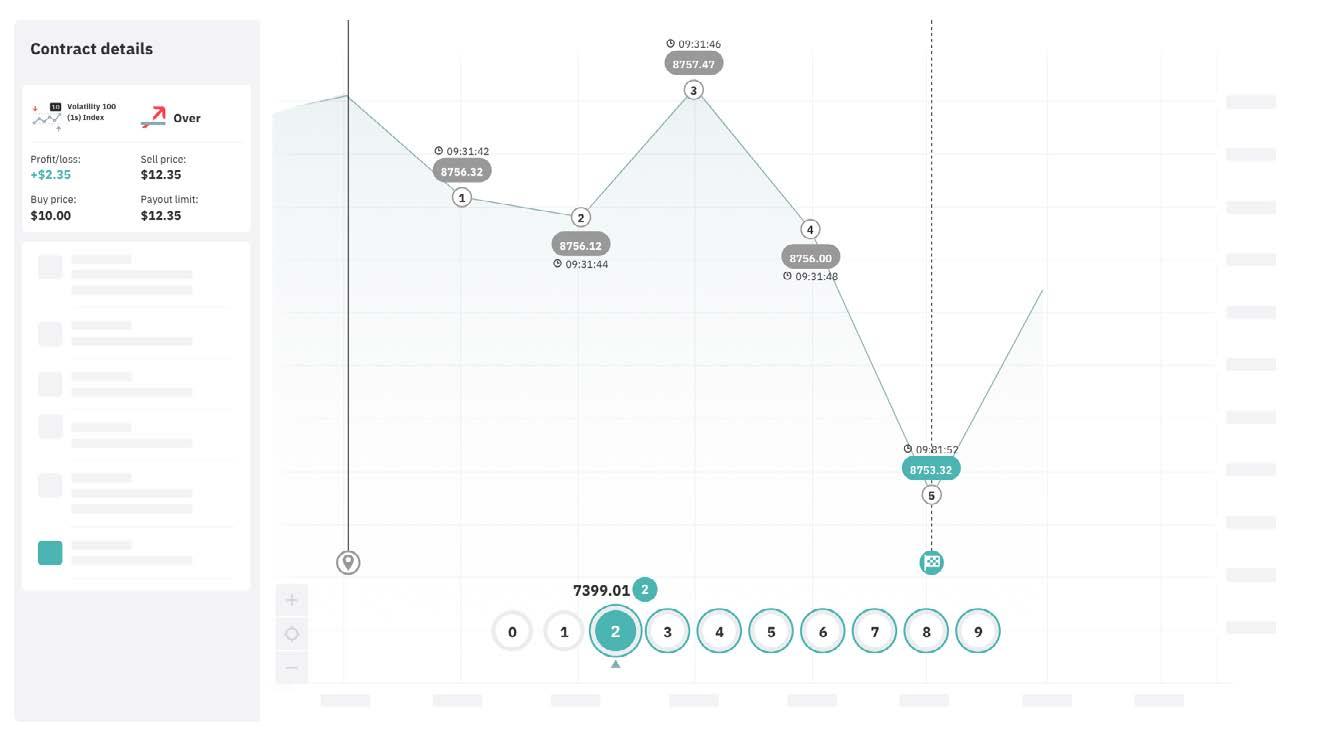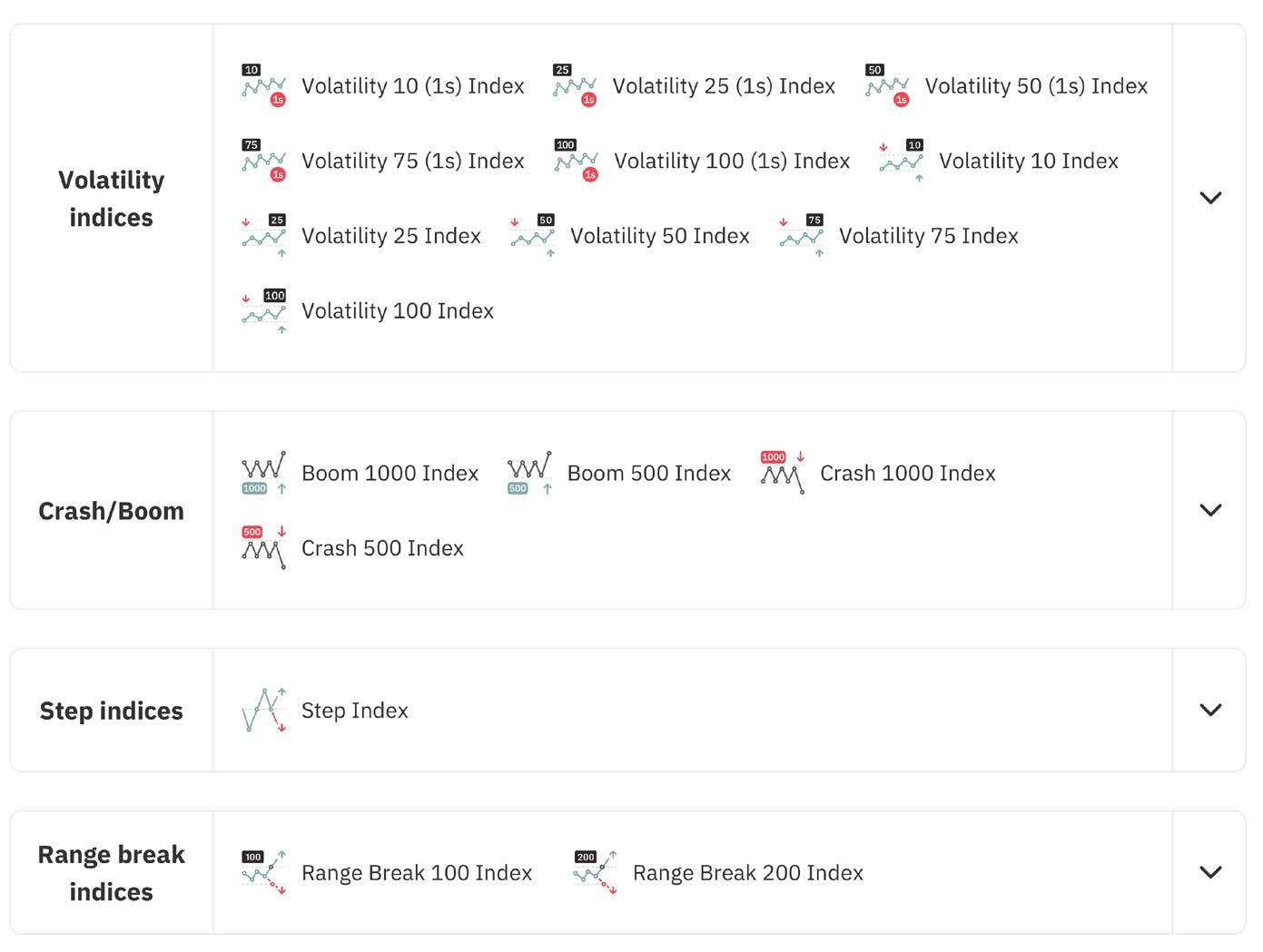
9 minute read
03
03 Platforms for trading synthetic indices
Deriv synthetic indices can be traded on various platforms to suit your own trading style and experience. Here, we will start with DTrader, which can be accessed via Deriv.app on a desktop or a mobile device on a browser. We will then look at MT5 (currently not available for Deriv UK clients) which gives you the widest choice of synthetic indices and access to a full suite of professional trading tools.
Advertisement
Dtrader
DTrader allows you to trade directly from the live chart. Deriv provides a continuous price feed for trading Rise (UP) or Fall (Down) as well as other ways to trade a synthetic index.
Have many choices
There is a range of synthetic indices which you can trade, from lower volatility (Vol 10) to higher volatility (Vol 100). These are continuous indices: they are literally ongoing 24/7/365 with constant deep liquidity, so no large gaps in prices.
Daily Reset Indices reset each day at midnight GMT. These are the Bear Market Index and Bull Market Index.
The Volatility 10 Index has volatility set at 10% so the range of price movements will be lower. At the other end of the spectrum, the Volatility 100 Index is set at 100%, so you will see fairly violent swings in prices which some systems and traders prefer. The Volatility 100 Index is twice as volatile as the Volatility 50 Index, and four times as volatile as the Volatility 25 Index.
Enjoy the thrill and stay safe
Digital options have a fixed payout and a fixed premium; your risk is strictly limited to your premium. In some markets, you can also close a digital option before expiration, which is another advantage that synthetic indices have since you can’t, for instance, close a forex digital option before it expires.
Be in control
With Deriv synthetic indices, you are in control of not only choosing the rate of volatility but also deciding the length of the contract. This can range from ticks to seconds to days.
With digital options, your trades settle automatically with no need to make a closing trade. If the trade moves according to your prediction, any profit that you make is added to your account balance automatically with no waiting for settlement.
You can also have a number of trades open simultaneously. For example, you could have a Rise (buy) trade on the Volatility 10 Index to settle in 1 hour and also have a Fall (sell) trade on the same index to settle in 1 minute.
Available option trades
When you trade synthetic indices on DTrader, there are many digital option trades that you can choose from, and Deriv is always adding more. Below, you are introduced to those offered on DTrader at the time that this book is being written.
Rise/Fall
Predict whether the exit spot will be strictly higher or lower than the entry spot at the end of the contract period.
Higher/Lower
Predict whether the exit spot will be higher or lower than a price target (the barrier) at the end of the contract period.
Matches/Differs
Predict what number will be the last digit of the last tick of a contract. The duration of this trade cannot exceed 10 ticks.
Over/Under
Predict whether the last digit of the last tick of a contract will be higher or lower than a specific number. The duration of this trade cannot exceed 10 ticks.
Even/Odd
Predict whether the last digit of the last tick of a contract will be an even number or an odd number. The duration of this trade cannot exceed 10 ticks.
Touch/No Touch
Predict whether the market will touch or not touch a target at any time during the contract period.
Two digital options trading examples
Let’s go through an example of trading synthetic indices as a Rise/Fall digital option:
2
1

3
Here we see the Volatility 10 Index with the price moving higher. We can choose our investment – in this case, $10 1 (that is our total risk) – the duration of the trade – in this case, 5 ticks – and the direction of movement we predict for the 2 market – in this case, Rise. 3
So, let’s see what happened:
We can see that the index closed higher than the purchase price, and our $10 investment has now gained $9.53 for a profit of 95.3%, which is not a bad return for a few seconds!

Notice the trade settles automatically after 5 ticks, so we don’t need to sell to close. Also, notice that initially, the trade went against us. However, this does not matter. It’s the closing price that is important. Neither does it matter if the final price is just marginally higher than the purchase price. We are still paid out.
Each trade, even if the trading capital is small, is given a unique reference ID number for the opening and closing. This means that each trade has a full audit trail that can be checked, so there is no way that the outcome can be manipulated either by Deriv or the trader.
You can also close a trade early with some digital options if there is enough time value left. In the image shown, Volatility 75 is still running and trade is going against us. We can sell the contract and salvage some of the price paid for the trade.

Now, let’s take a look at an example of Over/Under. In this example, I predicted that the last digit of the exit price would be above 1 for a 23.5% return. As you can see, it was a winning trade as the end digit was 2.

Deriv MetaTrader 5 (DMT5)1

MetaTrader 5 (MT5), developed by MetaQuotes Software, gives you access to multiple asset classes — forex, stocks, commodities, and indices — on a single platform. MT5 can be used on Android or iOS mobile devices as well as desktop PC or MAC.
Before we see how Deriv connects with MT5, let’s find out more about margin trading, the type of trading you can do on MT5.
1 Not currently offered to the clients in the UK
Margin trading
Margin trading allows you to make an investment using leverage. Now, what is leverage? Leverage gives you the chance to make an investment which is larger than your actual capital amount. A way to think of it is like a home loan or mortgage where you put up 10%, and the bank provides the rest.
For example, you have $1,000 in your account but would like to buy $10,000 worth of an index. Without leverage, this is impossible. But if a broker offers to boost your purchase power, or in other words, give you leverage, your wish can come true. Deriv offers up to 1:1000 leverage. With global interest rates remaining low, the cost of borrowing money remains low and leverage proves to be cost-effective. Leverage is offered at no extra charge.
Leverage magnifies your gains; of course, it will also magnify your losses. However, with Deriv, it is not possible to go into a negative balance because we can apply stop-out and forced liquidation measures to protect your account against losses that might exceed your equity. All the same, when trading CFDs, it is important to monitor your open positions closely because you may lose more than your initial investment if the price moves against your prediction. You can use stop loss to limit your risk.
Of course, just like a maximum speed limit, you don’t have to drive right at the limit, and you don’t have to take your account to maximum margin.
Used sensibly, leverage can help to build up your account. Just be aware of the downsides as well.
Now we know that the trading done on MT5 is leveraged. But there’s one more thing that we should look at before going back to Deriv MT5 and that is the type of contracts that you can purchase on this platform.
Contracts for difference (CFDs)
A contract for difference is a contract that gives you the chance to earn a payout by correctly predicting the price movement of assets without owning them. CFDs are available on a range of financial and synthetic markets and can be traded via MT5. A CFD gives you exposure to a market and allows you to go long (trade for price to go up) or short (trade for price to go down). The CFD will continue trading until you close it or it gets stopped out. Stop out occurs when your margin level (percentage of equity to margin) reaches a certain level that depends on your account type. Before this, your account will be placed under margin call which also depends on your account type. This does not affect your ability to open new positions; it serves to alert you that your floating losses have added up to a certain level. It is best that you top up your account to keep your positions open. Another option is to close losing positions or set a stop loss to prevent your losses from becoming bigger.
Why access MT5 through Deriv
Whether you’re a new or experienced trader, you can easily access the MT5 platform via DMT5. As a Deriv client, you can then trade CFDs on our unique synthetic indices. Select Deriv as your broker to gain access to synthetic indices.
You can use a demo account to practise margin trading or switch to your real account and trade CFDs for a real profit or loss.
Instruments availabe for margin trading

Other MT5 features
MT5 also offers a massive selection of plugins that allow automated trading. To see how Deriv makes it easy for you to automate your trades, read Appendix G on DBot. It also provides a virtual private server (VPS), which means that for a small monthly fee, your trading systems can run on a remote computer without needing to tie up your phone or laptop. This also means you’re not relying on your internet connection.
An MT5 trading example
In this example, you can see the volatility 10 chart and the Sell and Buy prices in MT5. We can choose our trade size. In this case, I have $1 a point. In this index, a point is 6,528.00 to 6,529.00. Imagine that I have sold $1 a point at 6,528.086 and the current price is 6,555.740 so I have a running loss of 27.65 points, which in this case equals -$27.65.

As you can see on the left-hand side, the widest selection of synthetic indices and multiple trades can be running concurrently.
Trading synthetic indices with Deriv on the MT5 platform gives you a high amount of leverage.




